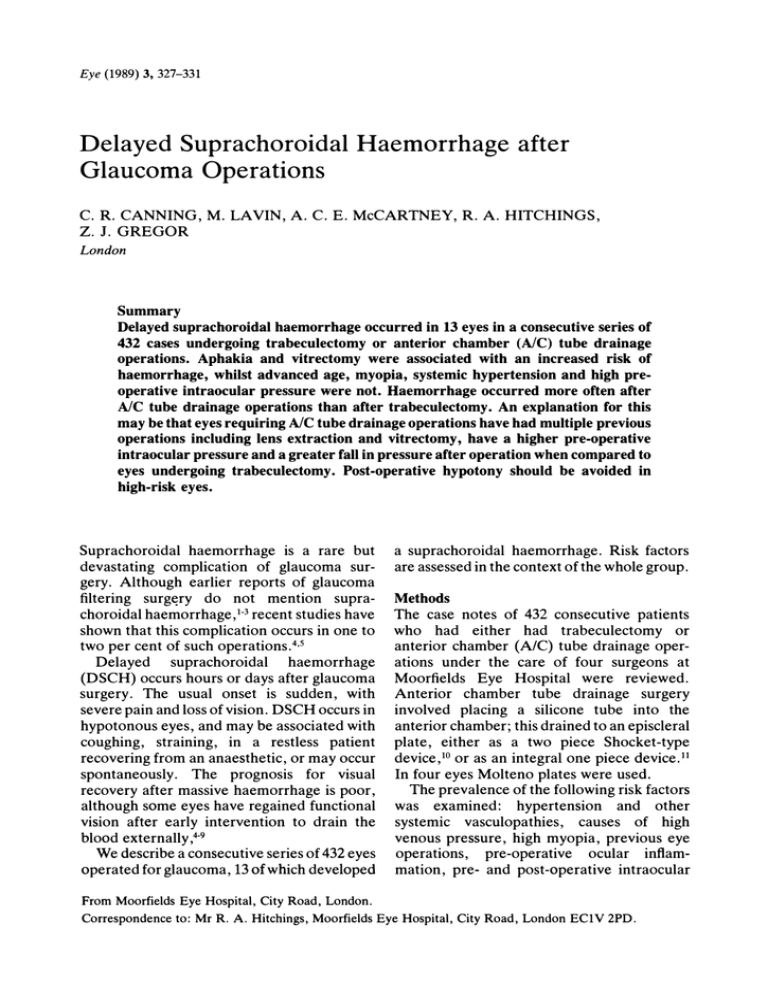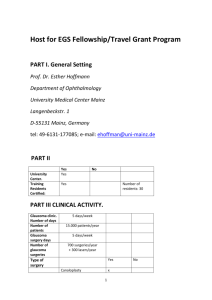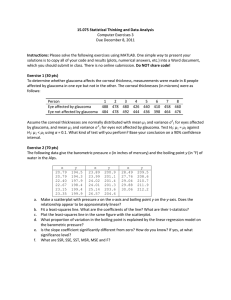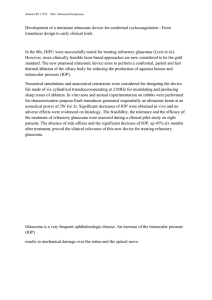Delayed Suprachoroidal Haemorrhage after Glaucoma Operations
advertisement

Eye (1989) 3, 327-331 Delayed Suprachoroidal Haemorrhage after Glaucoma Operations C. R. CANNING, M. LAVIN, A. C. E. McCARTNEY, R. A. HITCHINGS, Z. J. GREGOR London Summary Delayed suprachoroidal haemorrhage occurred in 13 eyes in a consecutive series of 432 cases undergoing trabeculectomy or anterior chamber (AlC) tube drainage operations. Aphakia and vitrectomy were associated with an increased risk of haemorrhage, whilst advanced age, myopia, systemic hypertension and high pre­ operative intraocular pressure were not. Haemorrhage occurred more often after AlC tube drainage operations than after trabeculectomy. An explanation for this may be that eyes requiring AlC tube drainage operations have had multiple previous operations including lens extraction and vitrectomy, have a higher pre-operative intraocular pressure and a greater fall in pressure after operation when compared to eyes undergoing trabeculectomy. Post-operative hypotony should be avoided in high-risk eyes. Suprachoroidal haemorrhage is a rare but a suprachoroidal haemorrhage. Risk factors devastating complication of glaucoma sur­ are assessed in the context of the whole group. gery. Although earlier reports of glaucoma filtering surgery do not mention supra­ Methods choroidal haemorrhage, 1-3 recent studies have The case notes of 432 consecutive patients shown that this complication occurs in one to who two per cent of such operations.4•5 anterior chamber Delayed suprachoroidal haemorrhage (DSCH) occurs hours or days after glaucoma had either had (Ale) trabeculectomy or tube drainage oper­ ations under the care of four surgeons at Moorfields Eye Hospital chamber tube were reviewed. surgery. The usual onset is sudden, with Anterior drainage severe pain and loss of vision. DSCH occurs in involved placing a silicone tube into the surgery hypotonous eyes, and may be associated with anterior chamber; this drained to an episcleral coughing, plate, either as a two piece Shocket-type straining, in a restless patient recovering from an anaesthetic, or may occur device,IO or as an integral one piece device.ll spontaneously. In four eyes Molteno plates were used. The prognosis for visual recovery after massive haemorrhage is poor, The prevalence of the following risk factors although some eyes have regained functional was vision after early intervention to drain the systemic blood externally,4-9 venous pressure, high myopia, previous eye We describe a consecutive series of 432 eyes operated for glaucoma, 13 of which developed examined: hypertension vasculopathies, operations, pre-operative and causes other of ocular high inflam­ mation, pre- and post-operative intraocular From Moorfields Eye Hospital, City Road, London. Correspondence to: Mr R. A. Hitchings, Moorfields Eye Hospital, City Road, London EC1V 2PD. C. R. CANNING ET AL. 328 pressure, and post-operative valsalva (Table IV). In particular, eyes undergoing tube surgery had a mean intraocular pressure episodes. Suprachoroidal haemorrhage was diag­ drop from pre- to day one post-operation of nosed clinically by the presence of a dark mass 34 mm Hg, compared to 21 mm Hg for tra­ pushing the retina forward, with blood often beculectomies. More eyes in the tube group breaking through into the vitreous cavity. had had vitrectomies (19% vs 5%) and more Ultrasound was used to confirm the diagnosis were aphakic (49% vs 11%). The tube drain­ in some cases. Blood was found in all cases age group had on average had three previous where external scleral drainage was done. A eye operations, whereas less than half the tra­ haemorrhage causing a subtotal detachment beculectomy group had had any previous and not breaking through into the vitreous ocular surgery. One eye had a limited haemorrhage, and cavity was considered 'limited'. The standard error of the difference this was the only one whose visual acuity between means and the chi squared test were improved. used to compare subgroups. remained unchanged. The rest did not regain In one other eye the acuity pre-operative visual acuity, including all eight where the haemorrhage was drained. Results The 432 patients in this study comprised 265 males and 167 females. The mean age of the Discussion patients was 48.6 years (± 20.82). Trabeculec­ Delayed suprachoroidal nonexpUlsive haem­ tomy was performed on 254 eyes and tube orrhage (DSCH) is an uncommon but serious drainage complication on 178. The aetiology of the of glaucoma operations. A number of factors, both systemic and ocular, glaucoma is listed in Table I. Thirteen eyes had a delayed suprachoroidal have been implicated by association in the haemorrhage; in twelve of these the haemor­ pathogenesis. Many reports however do not rhage was massive. The 'risk' factors studied record the prevalence of such factors in are aphakia patients who did not have DSCH, making the detailed in Table II. Only (p<O.01) and vitrectomy (p<O.OI) were sig­ predictive value of such factors uncertain. nificantly associated with haemorrhage. Five Systemic of the 13 eyes with haemorrhage had had a hypertension,8.!O factors include advanced diabetes, other age,7.8 vascular trabeculectomy, and eight an AlC tube drain­ disease, general anaesthesia,4.7 Valsalva man­ age operation. The clinical features of these oeuvre and other causes of raised episcleral venous pressure7.8 and 5-fluorouridine admin­ patients are listed in Table III. Several differences were apparent between the trabeculectomy and tube drainage groups istration.8 Local ocular and orbital factors include previous ocular surgery,5 particularly lens extractions.8 and vitrectomy,5 high myo­ Table I pia4.7, Major causes of glaucoma PRIMARY: Congenital Chronic simple glaucoma Acute angle closure Chronic narrow angle SECONDARY: Aphakic Rubeotic Post-detachment operations Uveitis Pigmentary Trauma Failed glaucoma operations* nanophthalmos,7 disease, 67 133 27 19 uncontrolled inflammatory high eye pre-operative intraocular pressure,5.7 and prolonged post­ operative hypotony.8 In the series reported here, myopia, advanced age, systemic hypertension and high pre-operative intraocular pressure were not 48 significantly associated with haemorrhage. 30 23 reason for this is not known. Either may 14 13 10 19 *These patients also originally had other causes for their glaucoma. Aphakia and vitrectomy were, although the reduce the resistance to fluid accumulation in the suprachoroid. Such suprachoroidal effu­ sions are common after glaucoma operations in general, and Gressel et al.8 found serous choroidal effusions after trabeculectomy in all aphakic eyes which went on to develop DELAYED SUPRACHOROIDAL HAEMORRHAGE AFTER GLAUCOMA OPERATIONS Table II Factor s associated with suprachoroidal haemor r hage Haemor r hage (13 years) No haemor r hage (419 eyes) Age (years) Myopia >-6 dioptres Mean pre-operative blood pressure (mm Hg) Mean lOP pre- to postoperative (mm Hg) General anaesthesia Cataract extraction with or before glaucoma operation Vitrectomy with or before glaucoma operation SD NS = = (SD 20.81) 34 (SD 20.82) (SD 13.84) 39 2 103 (SD 16.19) NS NS NS (SD 8.91) 38 (SD 8.44) NS 421 115 13 11 NS p>O.OI 40 7 p<O.OI Clinical features of patients with delayed haemor r hage Sex Aetiology of glaucoma Aphakia a) Tr abeculectomy M CSG, aphakic 58 M aphakic 69 M congenital 23 15 F congenital M congenital 37 x b) Tube dr ainage 34 M CNAG x 79 40 57 14 42 26 15 49 31 99 Significance standard deviation. not significant at the 5 per cent level. Table III Age 329 M M F M M F M Vitrectomy x x x x x x VA final Time fr om Time fr om hge to operation dr ain of hge to hge x 180/100 160/100 150/80 110170 130190 6/60 6/36 6/60 6160 6112 PoL HM HM HM CF 2 1 1 4 1 x 150/85 HM NPL 2 days 140190 135190 170/100 90/60 140190 130190 120/80 6/36 PoL HM HM HM HM 6/60 CF NPL HM 6160 Pol NPL 1 4 3 2 3 1 3 x x rubeotic uveitis CNAG congenital uveitis congenital congenital BP VA pr e-op pr e-op (mm Hg) (mm Hg) x x x x x x days day day days day hr days days days days day days 12 days 2 days 4 wks 9 days 14 days 2 mths (enucleated) 4 days 4 days Aetiology-CSG chronic simple glaucoma; CNAG chronic narrow angle glaucoma. Visual Acuity (VA)-CF count fingers; HM hand movements; PoL perception of light NPL perception of light. = = = = DSCH. In our series, large choroidal effu­ sions were present in only two of the thirteen eyes that subsequently developed DSCH, and in one case the haemorrhage was limited. It seems unlikely, therefore, that large displace­ ments of the posterior ciliary artery cause rup­ ture through stretching. The intact lens-iris diaphragm and vitreous resist scleral deformation during hypotonia, whereas in the aphakic and/or vitrectomised eye scleral folding may place added stress on the ciliary arteries. In addition, the vitreous = = no and lens may limit the extent of haemorrhage if an artery does rupture. The incidence of suprachoroidal haemor­ rhage in two reported series of eyes under­ going trabeculectomy was 1. 6%5 and 2%. 4 In the present series we have found a similar incidence, namely 5/254 ( 2%) . Each of these eyes was either aphakic or vitrectomised at the time of surgery (Table III) , emphasising the importance of these risk factors. The incidence of DSCH in AlC tube drain operations in our series, however, was 8/178 c. R. CANNING ET AL. 330 Table IV Comparison of tr abeculectomy and tube dr ainage eyes Trabeculectomy (254 eyes) Suprachoroidal haemorrhage Age (years) Pre-operative lOP (mm Hg) Post-operative lOP day 1 (mm Hg) Cataract extraction with or before glaucoma operation Vitrectomy with our before glaucoma operation Myopia 5 56 32 11 (SD 18.76) (SD 11.32) (SD 8.88) 8 37 37 3 28 (11 per cent) 88 13 (5.1 per cent) 34 29 (11.5 per cent) 21 (4.4%). Eyes in this group had a higher pre­ operative intraocular pressure, a greater fall in pressure after the operation, and previous operations including cataract extraction and vitrectomy were more common. This suggests that the presence of an AIC tube drain does not itself constitute an independent risk factor. Although one series of 75 tube operations in neovascular glaucoma recorded 4 eyes suf­ fering DSCH,1O two other large series did not list this complication.12•13 The overall fre­ quency in these three series is 4/264 (1. 5%), which is much less than that seen in our study. These reports do not list the prevalence of aphakia or vitrectomy in their patients. In addition, it is likely that case selection for tube surgery varies between centres, and these factors together may explain the varying prev­ alence of DSCH in tube surgery. DSCH is primarily a complication of hypo­ tony. In an attempt to reduce the severity and duration of postoperative hypotony, we have used ligating sutures about the tube implant to temporarily obstruct outflow.14 This is an effective method for reducing the severity and duration of hypotony,14.15 although some patients develop post-operative pressure spikes and may require reoperation. A case history from our series emphasised the importance of hypotony. A 40 year old male with a myopic, aphakic, vitrectomised eye underwent a tube drain. The tube was tied with a Tube dr ain (178 eyes) tempo-rary suhue. The po-8t-operative intraocular pressure (lOP) was 21 mm Hg, and the pressure remained unacceptably high Significance NS p<O.OOI (SD 18.58) (SD 10.06) (SD 8.26) (49.4 per cent) (19.1 per cent) (11. 8 per cent) in the ensuing days (Figure). The ligature was therefore divided and the lOP fell to 2 mm Hg. Six hours later DSCH occurred. The results of treatment for the condition have been mixed. Several reports summarise the effects of early operative intervention on the visual outcome in eyes with massive suprachoroidal haemorrhage.4.6 Six of the eight eyes which had drainage of the haemor­ rhage with reformation of the anterior cham­ ber regained their pre-operative visual acuity. The time from haemorrhage to drainage of blood in successful cases, where reported, was within a week. Our experience does not conPressure (mm Hg) 50 40 1 2 , t 30 20 10 o -1 o 2 3 4 5 6 Time (days) Fig. Intraocular pressur e changes in an eye with an AIC tube dr ain which was initially tied with a suture. (1) AIC tube dr ain operation; (2) Sutur e cut; (3) DSCH occur r ed. DELAYED SUPRACHOROIDAL HAEMORRHAGE AFTER GLAUCOMA OPERATIONS firm this relatively good prognosis-all 8 eyes in which the haemorrhage was drained failed to regain their preoperative visual acuity. Only three of the eyes in our series were operated within a week of the haemorrhage, however. This delay may be an important factor in the eventual visual outcome. Early drainage of the haemorrhage does seem to offer the best chance of visual improvement. Our results indicate that aphakia and vitrec­ tomy are associated with a greater risk of DSCH after trabeculectomy and tube drain­ age surgery. We do not feel that the preva­ lence of this complication warrants abandoning such surgery in favour of cycloablative procedures in these eyes. Instead, attention should be directed at controlling post-operative hypotony. References I Mills KB: Trabeculectomy: a retrospective long­ term follow-up of 444 cases. Br J Ophthalmol 1981, 65: 790-5. 2 Zaidi AA: Trabeculectomy: a review and four year follow-up. Br J Opthalmol1980, 64: 436-9. 3 Jerndal T and Lundstrom M: 330 trabeculectomies. A long-time study (3-5 112 years) . Acta Ophthalmol1980, 58: 947-50. 4 Ruderman JR, Harbin TS, Campbell DG: Post­ operative suprachoroidal hemorrhage following filtration procedures. Arch Ophthalmol 1986, 104: 201-5. 5 Givens K and Shields MB: Suprachoroidal hemor­ rhage after glaucoma filtering surgery. Am J Opthalmol1987, 103: 689-94. 6 331 Abrams GW, Thomas MA, Williams GA, Burton TC: Management of postoperative suprachoroi­ dal hemorrhage with continuous-infusion air pump. Arch Ophthalmol1986, 104: 1455-8. 7 Frenkel REP and Shin DH: Prevention and manage­ ment of delayed suprachoroidal hemorrhage after filtration surgery. Arch Ophthalmol 1986, 104: 1459--63. 8 Gressel MG, Parrish RK, Heuer DK: Delayed non­ expulsive suprachoroidal hemorrhage. Arch Ophthamol1984, 102: 1757--60. "Cantor LB, Katz LJ, Spaeth GL: Complications of surgery in glaucoma. Ophthalmology 1985, 92: 1266-70. 10 Shocket S: Investigation of the reasons for success and failure in the anterior shunt-to-the-encircling­ band procedure in the treatment of refractory glaucoma. Trans Am Ophthalmol Soc 1986, 84: 743-9. II Joseph NH, Sherwood MB, Trantas G, Hitchings RA, Lattimer JL: A one piece drainage system for glaucoma surgery. Trans Ophthalmol Soc UK 1986, 105: 657--64. 12 Molteno ACB: The use of draining implants in resis­ tant cases of glaucoma. Trans Ophthalmol Soc NZ 1983, 35: 94-7. 13 Krupin, T, Kaufman P, Mandell AI, Terry SA, Ritch R, Podos SM, Becker B: Long term results of valve implants in filtering surgery for eyes with neovascular glaucoma. Am J Ophthalmol 1983, 95: 775-82. 14 Rose GE, Lavin MJ, Hitchings RA: Silicone rubber drainage tubes in glaucoma surgery: theoretical requirements, practical experience and short­ term intraocular pressure control. Eye. ( submit­ ted for publication ) . 15 Molteno ACB, Polkinghorne PJ, Bowbyes JA: The vicryl tie technique for inserting a draining implant in the treatment of secondary glaucoma. Aust NZ J Ophthalmol1986, 14: 343-54.






